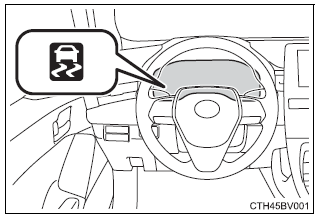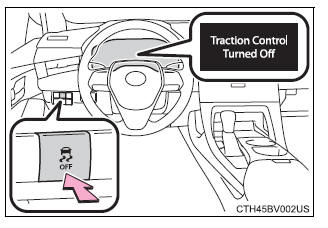Be aware, however, that these systems are supplementary and should not be relied upon too heavily when operating the vehicle.
ABS (Anti-lock Brake System)
Helps to prevent wheel lock when the brakes are applied suddenly, or if the brakes are applied while driving on a slippery road surface
Brake assist
Generates an increased level of braking force after the brake pedal is depressed when the system detects a panic stop situation
VSC (Vehicle Stability Control)
Helps the driver to control skidding when swerving suddenly or turning on slippery road surfaces.
Enhanced VSC (Enhanced Vehicle Stability Control)
Provides cooperative control of the ABS, TRAC, VSC and EPS.
Helps to maintain directional stability when swerving on slippery road surfaces by controlling steering performance.
Secondary Collision Brake
When the airbag sensor detects a collision, the brakes and brake lights are automatically controlled to reduce the vehicle speed and that helps reduce the possibility of further damage due to a secondary collision
TRAC (Traction Control)
Helps to maintain drive power and prevent the drive wheels from spinning when starting the vehicle or accelerating on slippery roads
Hill-start assist control
Helps to reduce the backward movement of the vehicle when starting on an uphill
EPS (Electric Power Steering)
Employs an electric motor to reduce the amount of effort needed to turn the steering wheel
Adaptive Variable Suspension System (if equipped)
By independently controlling the damping force of the shock absorbers for each of the 4 wheels according to the road and driving conditions, this system helps riding comfort with superior vehicle stability, and helps good vehicle posture
When the TRAC/VSC systems are operating
The slip indicator light will flash while the TRAC/VSC systems are operating.

Disabling the TRAC system
If the vehicle gets stuck in mud, dirt or snow, the TRAC system may
reduce power from the engine to the wheels. Pressing  to turn
the system off may make it easier for you to rock the vehicle in order
to free it.
to turn
the system off may make it easier for you to rock the vehicle in order
to free it.
To turn the TRAC system off,
quickly press and release  .
.
"Traction Control Turned Off" will be shown on the multi-information display.
Press  again to turn the system
back on.
again to turn the system
back on.

â– Turning off both TRAC and VSC systems
To turn the TRAC and VSC systems off, press and hold  for more than 3
seconds while the vehicle is stopped.
for more than 3
seconds while the vehicle is stopped.
The VSC OFF indicator light will come on and the "Traction Control Turned Off" will be shown on the multi-information display*.
Press  again to turn the systems back
on.
again to turn the systems back
on.
*: Pre-collision brake assist and pre-collision braking will also be disabled.
The pre-collision system warning light will come on and the message will be shown on the multi-information display.
â– When the message is displayed on the multi-information display showing
that TRAC has been disabled even if  has not been pressed
TRAC cannot be operated. Contact your Toyota dealer.
has not been pressed
TRAC cannot be operated. Contact your Toyota dealer.
â– Operating conditions of hill-start assist control
When the following four conditions are met, the hill-start assist control will operate:
â– Automatic system cancelation of hill-start assist control
The hill-start assist control will turn off in any of the following situations:
â– Sounds and vibrations caused by the ABS, brake assist, VSC, TRAC and hill-start assist control systems
â– EPS operation sound When the steering wheel is operated, a motor sound (whirring sound) may be heard. This does not indicate a malfunction.
â– Automatic reactivation of TRAC and VSC systems After turning the TRAC and VSC systems off, the systems will be automatically re-enabled in the following situations:
If both the TRAC and VSC systems are turned off, automatic re-enabling will not occur when vehicle speed increases.
â– Secondary Collision Brake operating conditions The vehicle speed is approximately 6 mph (10 km/h) or more and the airbag sensor detects a collision. (The Secondary Collision Brake will not operate when the vehicle speed is below approximately 6 mph [10km/h].)
â– Secondary Collision Brake automatic cancellation
The Secondary Collision Brake is automatically canceled in the following situations:
â– Reduced effectiveness of the EPS system The effectiveness of the EPS system is reduced to prevent the system from overheating when there is frequent steering input over an extended period of time. The steering wheel may feel heavy as a result.
Should this occur, refrain from excessive steering input or stop the vehicle and turn the engine off. The EPS system should return to normal within 10 minutes.
| WARNING â– The ABS does not operate effectively when
â– Stopping distance when the ABS is operating may exceed that of normal conditions The ABS is not designed to shorten the vehicle's stopping distance. Always maintain a safe distance from the vehicle in front of you, especially in the following situations:
â– TRAC/VSC may not operate effectively when Directional control and power may not be achievable while driving on slippery road surfaces, even if the TRAC/VSC system is operating. Drive the vehicle carefully in conditions where stability and power may be lost. â– Hill- start assist control does not operate effectively when
â– When the TRAC/VSC is activated The slip indicator light flashes. Always drive carefully. Reckless driving may cause an accident. Exercise particular care when the indicator light flashes. â– When the TRAC/VSC systems are turned off Be especially careful and drive at a speed appropriate to the road conditions. As these are the systems to help ensure vehicle stability and driving force, do not turn the TRAC/VSC systems off unless necessary. â– Secondary Collision Brake Do not overly rely on the Secondary Collision Brake. This system is designed to help reduce the possibility of further damage due to a secondary collision, however, that effect changes according to various conditions. Overly relying on the system may result in death or serious injury. â– Replacing tires Make sure that all tires are of the specified size, brand, tread pattern and total load capacity. In addition, make sure that the tires are inflated to the recommended tire inflation pressure level. The ABS, TRAC and VSC systems will not function correctly if different tires are installed on the vehicle. Contact your Toyota dealer for further information when replacing tires or wheels. â– Handling of tires and the suspension Using tires with any kind of problem or modifying the suspension will affect the driving assist systems, and may cause a system to malfunction. |
Toyota Avalon (XX50) 2019-2022 Service & Repair Manual > Audio / Video: Active Noise Control Ecu
Components COMPONENTS ILLUSTRATION *1 LOWER INSTRUMENT PANEL SUB-ASSEMBLY *2 STEREO COMPONENT EQUALIZER ASSEMBLY Installation INSTALLATION PROCEDURE 1. INSTALL STEREO COMPONENT EQUALIZER ASSEMBLY (a) Engage the guide and install the stereo component equalizer assembly with the nut. (b) Connect the c ...